Samsung Galaxy S 4 Review - Part 1
by Brian Klug on April 24, 2013 12:01 AM ESTBattery Life and Charge Time
The Galaxy S 4 features a removable 9.88Wh battery with 3.8V chemistry. The battery design is par for the course for any high end smartphone, but the fact that it's removable remains a staple of the Galaxy S design. Whether or not the bulk of consumers actually use the flexiblity offered by a removable battery is up for debate, but there's no doubt about the fact that Samsung has a strong following of users who appreciate the feature.
Unfortunately, only having access to the Sprint version of the Galaxy S 4 to review, most of our battery life tests on the cellular network aren't all that useful. The good news is that our WiFi tests should at least give you an idea of how well the SGS4 will compare to the HTC One when both are on the same network. We're using the latest revision of our smartphone battery life test to compare performance of all the key players here. This is now our sixth revision of the battery life test, and we feel is the optimal balance between challenging workloads and idle time. The basic overview is the same as the previous test — we load webpages at a fixed interval until the handset dies, with display set at exactly 200 nits as always. Power saving features are disabled if they turn on automatically, and background account sync is disabled. The test is performed over both cellular data on all available air interfaces and over WiFi in an environment with good signal levels. The new test has decreased pause time between web page loads and added a number of JavaScript-heavy pages. I sat down with some UMTS RRC (Radio Resource Control) emulator tools and also made sure we had a good balance of all the RRC states (DCH, PCH if possible, FACH, IDLE) so we weren’t heavily biased towards one mode or the other.
As the most relevant comparison of platforms we have today, we'll start with the WiFi version of our web browsing test:
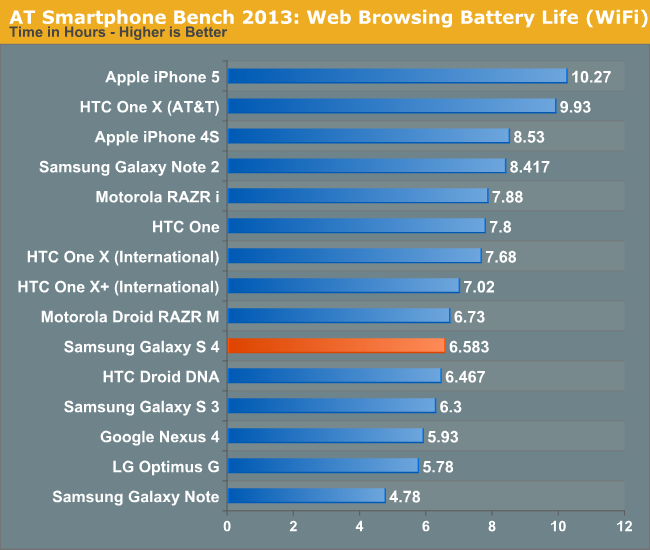
On WiFi the Galaxy S 4 falls behind the HTC One by an appreciable amount, however there's still an improvement in battery life compared to the Galaxy S 3. The Galaxy S 4's battery life isn't bad by any means, but do keep in mind that this is a large phone with a large display and a very powerful SoC. For much of the past year we've been talking about an increase in dynamic range in total platform power of high end smartphones and the Galaxy S 4 is no exception. Run it at full brightness or keep many cores running in their maximum performance states for a considerable period of time and you'll be greeted by a phone that's quickly in need of a power outlet.
As I mentioned earlier, we only have access to the Sprint version of the Galaxy S 4 at this point which unfortunately means that our 3G results aren't all that comparable to other devices here.

Even on Sprint, the Galaxy S 4 does surprisingly well.
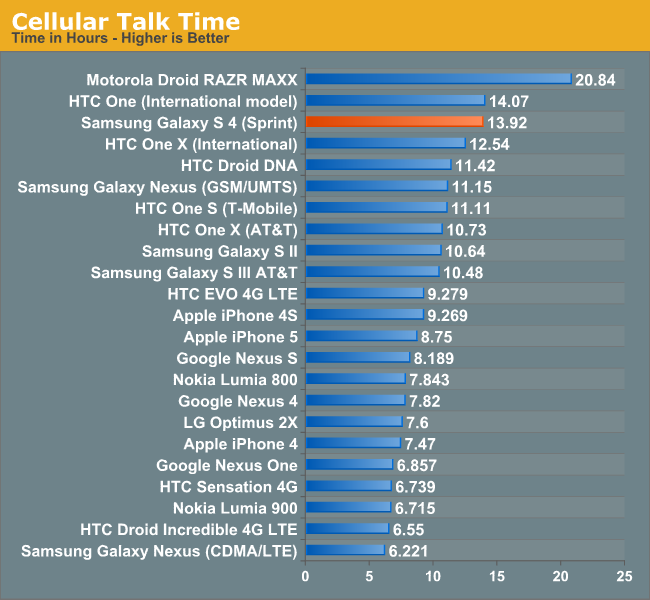
Talk time is excellent on the Galaxy S 4, with the phone delivering effectively the same battery life as the HTC One. Without having to power on that huge display, the Galaxy S 4 can last for a very long time on a single charge.
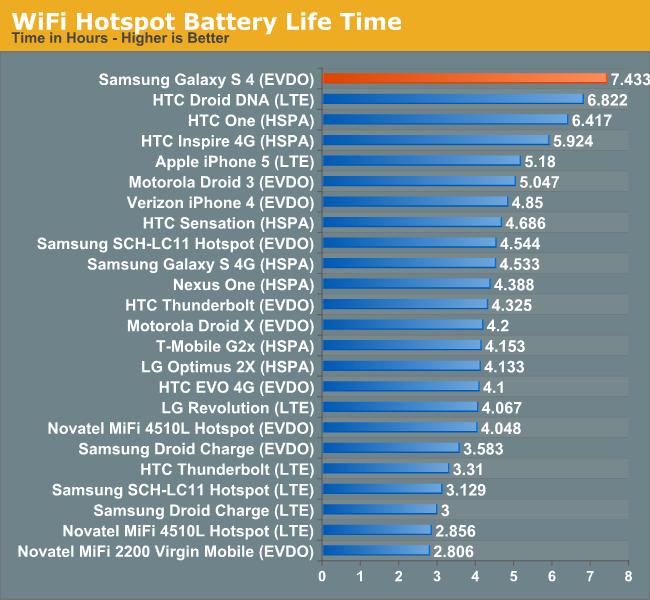
A combination of the Sprint network and the fact that the Galaxy S 4's display remains off during our hotspot test resulted in great battery life here as well. Again, this data isn't all that useful if you're not on Sprint but Samsung tells us we should be able to get our hands on an AT&T SGS4 in the not too distant future.
Charge Time
Samsung appears to implement Qualcomm's Quick Charge specification in the Galaxy S 4 and its bundled charger. I realize we haven't done a deep dive into what Quick Charge is and how it works, but I'll try to go through a quick explanation here. Most conventional chargers are linear, they take a fixed amount of input current (at 5V) and pass it along to the device being charged. The problem is that at deeply discharged states, the device's battery might be at a substantially lower voltage. A traditional linear charger won't change the current supplied based on the voltage of the battery being charged, and as a result can deliver sub-optimal charge times. When implemented, Qualcomm's Quick Charge technology can vary output current based on the voltage of the battery being charged, which results in less power being dissipated as heat and more being delivered to charging the battery itself. The table below helps illustrate the savings:
Quick Charge, at least in its currently available 1.0 specification, is still bound by the 5V limits of the USB BC 1.2 specification. The next revision of Quick Charge will enable higher voltage operation for even faster charge times.
| Qualcomm Quick Charge 1.0, Theoretical Example | ||||||
| Input Current @ Voltage | Input Power | Output Current @ Discharged Battery Voltage | Output Power | |||
| USB BC 1.2 - Linear Charger | 475mA @ 5V | 2.375W | 475mA @ 3V | 1.425W | ||
| Qualcomm Quick Charge 1.0 | 475mA @ 5V | 2.375W | 700mA @ 3V | 2.100W | ||
The non-linear nature of Quick Charge significantly shortens charge time, particularly in the very early stages of charging when the device's battery is presumably fully discharged. As the device's battery voltage increases, current delivery tapers off and the QC advantage is no longer as great as a standard USB BC 1.2 solution. The end result though is significantly improved charge times.
The graph below shows the benefits of using Samsung's own charger vs. a standard charger that implements the USB BC 1.2 specification. When used with the bundled charger, the Galaxy S 4 recharges much faster than HTC's One, despite using a larger battery. Obviously the Galaxy S 4 will charge with any USB charger, but the charge time will simply be longer. Samsung uses a voltage divider and signals the presence of their own charger by sending 1.2-1.3 V across the D+ / D- pins, this is similar to what Apple does with 2.0 or 2.8 V across the pins for various USB chargers they've shipped over the years. This signaling is essentially Samsung's proprietary tablet charging signaling which they've employed on the Galaxy Note 2 and now SGS4, in fact the two use the same exact charger, so it's worth tossing out your old ones and getting the appropriate one to take advantage of the faster charging.
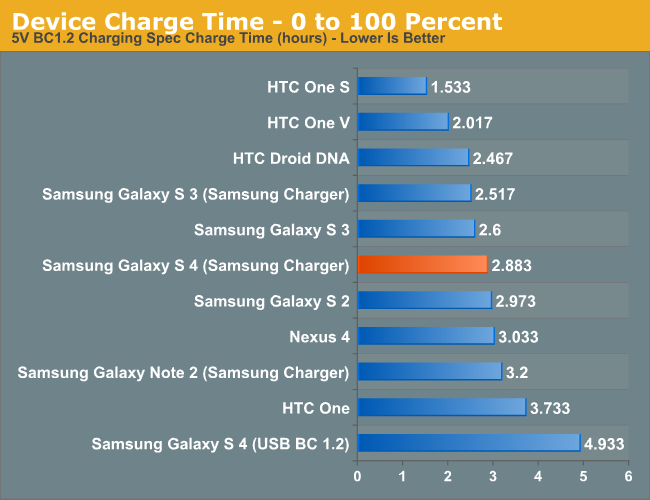


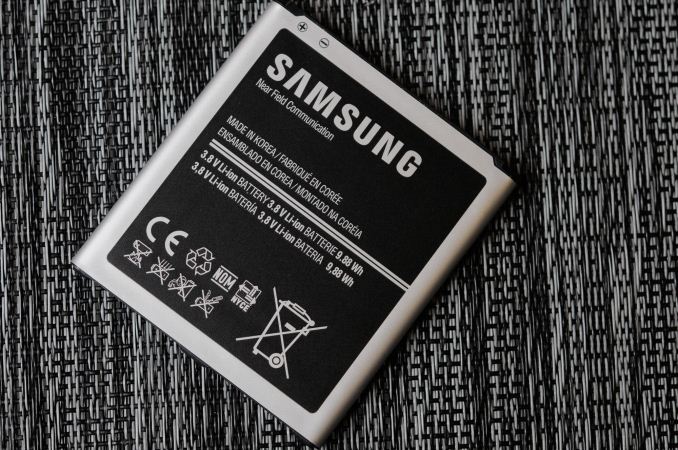








335 Comments
View All Comments
Notmyusualid - Wednesday, April 24, 2013 - link
Exactly - mine won't see a case at all.I wanted to hold out for my removable battery & SD slot, but since my SGS2 had such poor audio, (thus meaning I often missed calls in a noisy communications / server environment), I gave in, and my new HTC One will arrive tomorrow.
I might have lived with the plastic though, I had no case on my SGS2, and loved how light it was.
A 4" version of either the SGS4 or HTC One with no skimping on internals would have me jumping for joy though...
Thegonagle - Wednesday, April 24, 2013 - link
I usually put phones in a case when I'm going out (and definitely if I'm carrying my smartphone on the job instead of my flip phone), but I like using them naked at home. So design still matters.cdef - Saturday, April 27, 2013 - link
This phone really doesn't even need a case unless the owner is especially clumsy. Gorilla Glass 3 is pretty impressive. My Galaxy Nexus is unscathed after two years with it's "fortified glass" of unspecified brand. Naked phones FTW.sAiyAnstAr - Thursday, May 2, 2013 - link
I don't use cases anyway, so that point to me is not valid. I have the HTC Sensation and ONE X and have dropped them both numerous times on the face and back. The ONE X's plastic case is more worse-for-wear even though its newer than my Sensation.Diorarat - Thursday, August 1, 2013 - link
Gs4 is a cheap plastic phone. It is cheap because of the played out the design. When I shell out cash for a premium phone I want to feel that it is premium. When I hold a gs4 it feels like playing with cheaper variants that look the same. There is the galaxy note, galaxy s3, galaxy s3 mini, galaxy grand, galaxy mega, galaxy duos and a lot more. Don't get me wrong, i had a galaxy s3 and it was a beautiful phone when it came out. But Samsung abused it's popularity by making all phones look the same at the expense of the premium feel of the galaxy S line. Htc is by far the best designed phone you can get with the same price range. It packs the same punch as a galaxy s4 at the same price with better hardware. "build, sounds, and camera *depending on how you use it"blue_urban_sky - Wednesday, April 24, 2013 - link
I believe that plastic is also chosen so it can be removable.dyc4ha - Wednesday, April 24, 2013 - link
The Chinese version of the HTC One has a removable back plate with dual sim AND microsd expansiontheblueprint - Wednesday, April 24, 2013 - link
I'm living in China now and I just found the removable back one quite disturbing, it boost the thickness to 10.2mm, and I have to give up theunibody aluminum, which is the only thing that one is superior to s4. In this case I would definitely go for a s4 with Exynos 5410blue_urban_sky - Friday, April 26, 2013 - link
I'd like to see that it must be an engineering nightmare to pull that off well.Chloiber - Thursday, April 25, 2013 - link
Right, because all removable backs up until now (including all Nokia phones from the last 10 years) have been plastic.Oh wait!